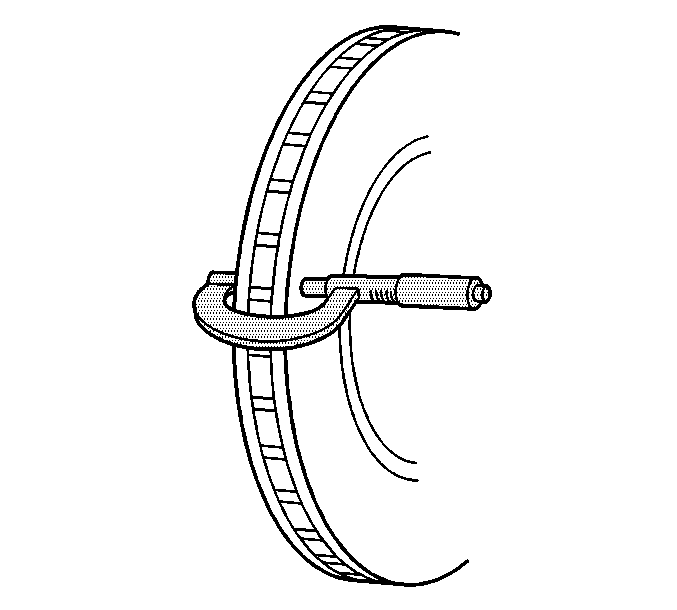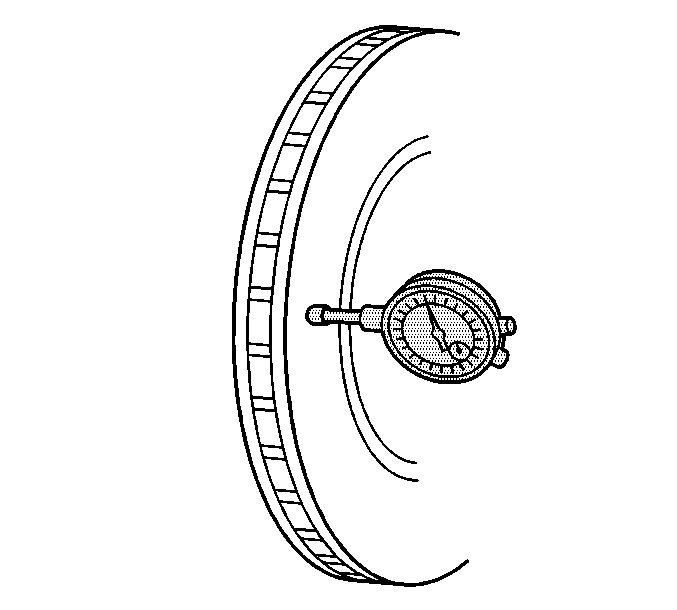For 1990-2009 cars only
Tools Required:
J 8001 Dial Indicator, or equivalent
- With the tire and wheel assemblies removed and the brake rotors retained by wheel lug nuts, clean the braking (friction) surfaces of the brake rotor with denatured alcohol or an equivalent approved brake cleaner.
- Inspect the braking surfaces of the brake rotor for the following Braking Surface Conditions:
- If the braking surfaces of the brake rotor exhibits one or more of the Braking Surface Conditions, the rotor requires refinishing or replacement.
- Using a micrometer calibrated in ten-thousands of an inch, measure and record the thickness variation of the brake rotor at four or more points, around the rotor.
- Compare the thickness variation recorded to the following specification:
- If the brake rotor thickness variation exceeds the specification, the rotor requires refinishing or replacement.
- Using the micrometer, measure and record any grooves present on the rotor braking surface.
- Compare the groove (scoring) depth recorded to the following specification:
- If the brake rotor scoring depth exceeds the specification, or if an excessive amount of scoring is present, the rotor requires refinishing or replacement.
- Mount a dial indicator, J 8001 or equivalent, and position the indicator button so it contacts the brake rotor at a 90 degree angle, approximately 13 mm (0.5 in) from the rotor's outer edge.
- Measure and record the lateral runout of the brake rotor.
- Compare the lateral runout of the brake rotor to the following specification:
- If the brake rotor lateral runout exceeds the specification, the rotor requires refinishing or replacement.
| • | Heavy rust and/or pitting |
| • | Light surface rust can be removed with an abrasive disc. Heavy surface rust and/or pitting must be removed by refinishing the rotor. |
| • | Cracks and/or heat spots |
| • | Excessive blueing discoloration |

Ensure that the measurements are only taken within the brake pad lining contact area and that the micrometer is positioned the same distance from the outside edge of the rotor for each measurement.
Specification (Front and Rear)
Brake rotor maximum allowable thickness variation 0.025 mm (0.001 in).
Specification (Front and Rear)
Brake rotor maximum allowable scoring 1.50 mm (0.059 in).

| 11.1. | Rotate the rotor until the lowest reading is displayed on the indicator dial, then zero the dial. |
| 11.2. | Rotate the rotor until the highest reading is displayed on the dial. |
| 11.3. | Measure and record the amount of sealed wheel bearing play, then subtract the bearing play from the lateral runout recorded to obtain the true amount of lateral runout. |
Specification (Front)
Brake rotor maximum allowable lateral runout 0.06 mm (0.002 in).
Specification (Rear)
Brake rotor maximum allowable lateral runout 0.06 mm (0.002 in).
